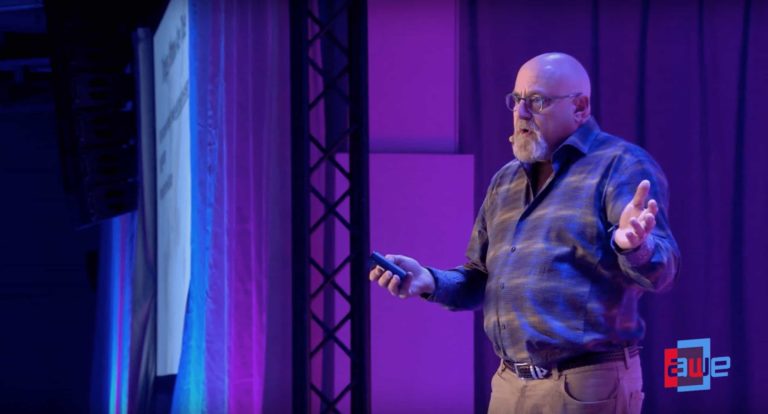
The metaverse is as exciting as it is ill-defined. The term is so overused that it’s nearly lost all meaning. Its two main tracks have also been conflated. One involves virtual synchronous worlds, while the other adds digital dimension to the physical world. Both will take years to actualize.
Meanwhile, the M-word continues to be a runaway train in tech circles. Though it carries legitimate principles in projecting what our connected future may look like, it’s been obscured as it’s applied to every unfitting (sometimes-comical) product launch and press release imaginable.
But cutting through all that noise are a few voices of reason and clarity. Matthew Ball is one of them, including his Metaverse Primer and “money where his mouth is” ETF. Another voice is Charlie Fink, whose 2018 Book “Charlie Fink’s Metaverse” was an XR-centric look ahead.
More recently, Fink gave a landscape view of the metaverse at AWE USA. This includes orbiting parts such as terminology, historical lessons, and the big-tech players placing their chips today. We’re featuring the presentation for this week’s XR Talks (video and takeaways below).
Capital M
First, it’s clear that Meta’s name change has amplified the m-word over the past few months. But that wasn’t the beginning, as the metaverse temperature has been rising over the past year. A lot of that was driven by Zuckerberg and co signaling their intentions and upcoming pivot.
Going back further, the metaverse qualities and attributes that seem to make up today’s consensus can be seen in Second Life, which has been around since the early 2000s. That and subsequent multiplayer experiences like Fornite and Roblox are metaverse-like fiefdoms.
This is an important distinction, says Fink, given that one of the most important qualities of an eventual metaverse is interoperability. In other words, Fortnite et al. are “a metaverse” (lowercase m), as opposed to “the Metaverse” (capital M). The latter doesn’t exist yet but is the vision.
If we’re to get to “the Metaverse,” several moving parts are needed to comprise a purpose-built tech stack. The model is the web in that it has many components of that stack: networking technologies, protocols, an interoperable front-end (the browser), and common languages.
Other key parts of that stack will include identity (avatars or otherwise), payment rails, common units of value (currency) and web-like standards. For example, one question is who is going to be the ICANN of the metaverse – a universally recognized body to register identity.
Endowed with Authority
Some of that registration and authentication could be done through the blockchain as opposed to a central entity. But Fink espouses an agnostic body that’s endowed with authority by all the major players….which could be unlikely given divergent and deep-pocketed interests.
In fact, that’s one factor that could prevent the metaverse from getting off on the same agnostic foot that the web did. The web’s infrastructure and governance pre-date big tech. The same can’t be said now, meaning today’s giants will invariably influence the metaverse’s makeup.
That brings us back to Meta, which Fink says is investing “ridiculous sums of money” to be at the center of it all (though it may not want to own it). That ended up being validated in Meta’s subsequent Q4 earnings which quantified about $10 billion in 2021 Meta Reality Labs losses.
These investments could be a double-edged sword. As we’ve asserted, Meta is doing AR and VR a favor (and the broader metaverse in this case) by investing so heavily to accelerate the technology. But could its resulting influence steer the metaverse in self-interested directions?
The answer is likely yes, but that will be answered in time. And based on the stages of all those layers of the metaverse stack, it will be a rather long period of time. Similarly, the metaverse will evolve organically (like the web did), and will take forms that none of us are talking about today.
We’ll pause there and cue the full presentation from Fink below…






